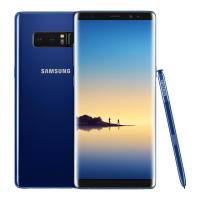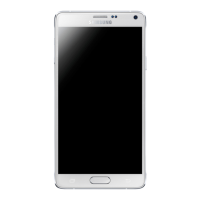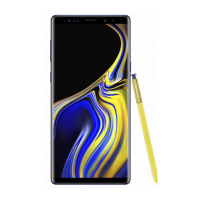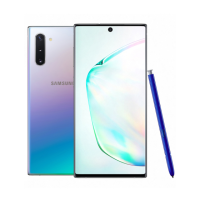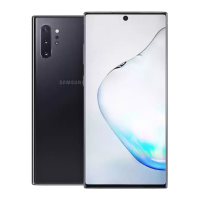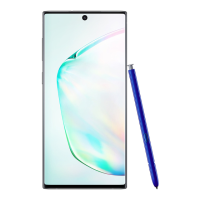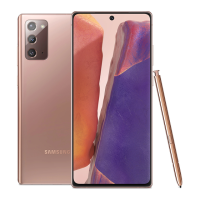Do you have a question about the Samsung Galaxy Note5 and is the answer not in the manual?
Explains how to use the guide to get the most out of the phone.
Provides instructions on how to learn about using your phone.
Illustrates phone's primary parts and key functions.
Outlines phone's primary external features and buttons.
Instructions to charge phone's battery using USB cable or computer.
Steps to power on the phone by pressing and holding the Power key.
Steps to turn off the phone by pressing and holding the Power key.
How to select items or press buttons on the screen by tapping with a finger.
How to open options for an item by touching and holding it.
Dragging finger vertically or horizontally across the screen to swipe or slide.
How to move items on screen by pressing, holding, and dragging.
Moving finger in light, quick strokes to flick through lists.
Changing screen orientation from portrait to landscape by turning phone sideways.
Using two fingers to zoom in or out on the screen.
Setting up phone features and preferences through welcome and setup screens.
Overview of phone's basic operations from home screen or apps list.
Customizing phone's settings and options through the Settings menu.
Changing screen orientation from portrait to landscape.
Capturing screenshots using power and home keys or palm swipe.
Using S Pen for creating and collaborating on the phone.
Hovering S Pen over items to display more information.
Quickly activating frequently used apps or performing actions with S Pen.
Creating notes that turn written text into actions on the device.
Capturing content on screen to add to Scrapbook or share.
Capturing screenshots and writing notes on them.
Creating, editing, and managing notes on the phone with the S Note app.
Accessing and launching installed applications from the apps list.
Overview of preinstalled apps and their functions/services.
Displaying the phone's wireless phone number.
Turning off signal-emitting functions while leaving phone on for offline apps.
Typing on phone using touchscreen Samsung keyboard or Google voice typing.
Using the touchscreen keyboard for text entry.
Using voice recognition to convert speech to text.
Creating a Google Account online or using the phone.
Signing into an existing Google Account with phone.
Protecting device from unauthorized use after factory reset.
Installing applications from Google Play store.
Finding and installing apps from Google Play.
Updating apps automatically or directly from Play Store.
Uninstalling apps downloaded from Google Play.
Turning screen off when not in use to save battery power.
Turning screen on and unlocking it using pattern, PIN, password, or fingerprint.
Updating phone software using the system update option.
Starting point for phone's applications, functions, and menus.
Extending home screen beyond initial screen to display additional screens.
Providing more space for icons, widgets, and more on home screen.
Displays phone status info and notification alerts at the top of the screen.
Accessing full notification panel by pulling down the status bar.
Quickly accessing frequently used settings options from notification panel.
Directly dialing, answering incoming calls, and using in-call screen options.
Placing a call using the phone's dialer screen.
Placing calls to 9-1-1 even if phone screen is locked or account restricted.
Answering incoming calls by dragging Answer to the right.
Rejecting incoming call and automatically sending a text message.
Onscreen options available during a call.
Contacts app layout and its various features.
Adding contacts with details like name, phone numbers, and email addresses.
Viewing a contact's details by displaying a contact entry.
Adding or editing contact information, assigning caller ID picture, or customizing ringtone.
Deleting a contact from the contacts details page.
Quickly sharing contacts using Bluetooth, email, Gmail, or text messaging.
Sharing profile information with contacts, selecting specific contacts and additional info.
Importing contacts backed up to device storage.
Manually backing up contacts to phone memory for re-import.
Sending and receiving instant text and multimedia messages.
Composing and sending text messages on the phone.
Sending multimedia messages with pictures, voice, or video files.
Exchanging multimedia chat messages with other phones supporting enhanced messaging.
Saving a message as a draft and resuming composition later.
Receiving notifications for new text or multimedia messages.
Grouping messages into conversations or threads for easier viewing.
Using Google's Gmail service to send, receive, and manage messages.
Using the Email application to send and receive email from your webmail or other accounts.
Basics of using data services, managing user name, and launching data connections.
Protocols for encrypting sent/received data for secure connections.
Setting browser options for customization.
Launching the browser by tapping an icon to access the web.
Bookmarking favorite websites using browser menu options.
Viewing browsing history using browser menu options.
Using tabs to switch between websites quickly and easily.
Finding on-phone help with Chrome or visiting google.com/chrome for more info.
Camera's viewfinder screen and access to controls and options.
Teaching how to take pictures and record videos with phone's camera.
Taking high-resolution pictures using the phone's camera.
Recording high-quality videos using the phone's video camera.
Selecting various shooting modes to make pictures or videos special.
Viewing pictures and videos taken with phone's camera or downloaded.
Editing pictures by rotating, cropping, or deleting them.
Automatically enhancing picture's color, brightness, and saturation.
Rotating pictures 90 degrees clockwise using editing options.
Cropping pictures using editing tools.
Drawing on a picture using S Pen or finger.
Sending pictures and videos via email, multimedia messages, or social networks.
Sending pictures/videos as file attachments in email or Gmail messages.
Sending pictures/videos in a multimedia message (MMS).
Sending pictures/videos to phones or computers using Bluetooth.
Sharing pictures/videos from Gallery via various apps and social media sites.
Uploading videos to YouTube account from phone.
Adjusting camera settings using icons on main screen and full menu.
Staying connected to latest news and information from Sprint.
Locating any phone on Sprint family plan instantly.
Downloading new apps and games from Sprint.
Watching live TV and accessing movies on demand.
Purchasing, downloading, and playing music, ringtones, and ringback tones.
Checking weather and forecasts with 1Weather app.
Performing basic mathematical equations using the built-in calculator.
Creating and managing events, meetings, and appointments.
Setting alarms, viewing time zones, using stopwatch, and setting timer.
Discovering apps designed exclusively for Galaxy phone.
Viewing and watching pictures and videos, and basic editing.
Using Google's instant messaging and video calling service.
Determining location, finding directions, and browsing local businesses.
Watching movies and TV shows purchased on Google Play.
Browsing, shopping, and playing back songs from Google Play Music library.
Searching information saved on phone, in apps, and on the internet.
Posting updates, reading friend activity, uploading pictures, and check-ins on Facebook.
Capturing and sharing photos and videos with friends on Instagram.
Sending instant messages with friends using Facebook's Messenger app.
Creating and sharing spreadsheets quickly and easily with Microsoft Excel.
Free online storage for personal files accessible from multiple devices.
Staying organized with text, pictures, or audio notes.
Creating and sharing presentations quickly and easily with Microsoft PowerPoint.
Creating and sharing word processing documents with Microsoft Word.
Playing music files, browsing library, and creating playlists.
Managing sounds, images, videos, Bluetooth files, and other data.
Following NASCAR news, video highlights, and driver stats.
Listening to local FM radio stations on smartphone.
Managing health, setting fitness goals, and tracking progress.
Helping create, edit, and manage notes on the phone.
Voice recognition app to activate phone functions using voice commands.
Streaming radio service for finding and listening to music.
Managing Samsung Gear wearable devices.
Mobile payment service accepted at various retail locations.
Managing multimedia content captured with S Pen.
Sharing screens, windows, and data between PC and Samsung Android device.
Playing videos stored on your phone or synced from other devices.
Recording audio files and sharing them immediately.
Viewing videos on YouTube without signing in.
Transferring files between phone and PC using USB connector.
Enabling Wi-Fi and connecting to available Wi-Fi networks.
Manually setting Wi-Fi connection options.
Removing a connected Wi-Fi network.
Connecting directly to other Wi-Fi Direct devices without access point.
Configuring phone's Bluetooth capabilities.
Searching for and pairing Bluetooth devices.
Connecting to stereo audio and hands-free devices.
Transferring information between phone and other Bluetooth devices.
Receiving data from other devices via Bluetooth.
Disconnecting from networks to save battery and turn off connectivity features.
Sharing phone's data connection with other devices via Wi-Fi.
Sharing device's internet connection with computer.
Viewing data usage and setting data limits.
Configuring mobile network connections and data service.
Using NFC for sending information and mobile payments.
Paying for items by tapping phone at point-of-purchase.
Accessing network options like VPN, mobile networks, printers.
Printing from phone via Wi-Fi.
Mirroring phone's display on car's screen.
Managing VPNs to connect to secured local networks.
Overview of top-level settings categories.
Setting phone's lock screen options and security features.
Configuring privacy and safety features like location and emergency messaging.
Enabling simplified home screen layout and app interactions.
Enabling and managing accessibility-related applications.
Adding and managing email, social networking, and photo/video sharing accounts.
Backing up phone data and resetting to factory default settings.
Selecting phone language and configuring input methods.
Monitoring phone's battery usage and charge percentage.
Managing internal storage on the phone.
Setting date, time, and format options.
Accessing tips and guidelines for using the phone.
Activating new phone or checking in-service phone status.
Keeping phone up-to-date with latest software.
Accessing important phone information, legal, and safety details.
Setting up Wi-Fi Calling for improved voice and data coverage.
Turning Wi-Fi on/off, connecting to networks, and configuring advanced options.
Removing a connected Wi-Fi network.
Connecting directly to other Wi-Fi Direct devices without access point.
Configuring phone's Bluetooth capabilities.
Searching for and pairing Bluetooth devices.
Connecting to stereo audio and hands-free devices.
Transferring information between phone and other Bluetooth devices.
Receiving data from other devices via Bluetooth.
Disconnecting from networks to save battery and turn off connectivity features.
Sharing phone's data connection with other devices via Wi-Fi.
Sharing device's internet connection with computer.
Viewing data usage and setting data limits.
Configuring mobile network connections and data service.
Using NFC for sending information and mobile payments.
Paying for items by tapping phone at point-of-purchase.
Accessing network options like VPN, mobile networks, printers.
Scanning for and connecting to nearby devices.
Printing from phone via Wi-Fi.
Managing VPNs to connect to secured local networks.
Overview of device's battery, storage, and RAM status.
Viewing and configuring settings for all apps on the phone.
Managing downloaded and preloaded applications.
Setting or clearing default applications for built-in phone features.
Configuring settings for the phone's Calendar app.
Configuring settings for the phone's Camera app.
Configuring options for contacts stored on your phone.
Configuring options for email accounts you set up on your phone.
Configuring internet settings to customize the browser.
Controlling options for text and MMS messages.
Setting options for the Music application.
Configuring options for calling with your phone.
Configuring options for using voice to interact with your phone.
Configuring weather settings for lock screen and Calendar app.
Configuring Google services.
Controlling phone's audio and vibration settings.
Switching between sound modes.
Setting phone to vibrate while ringing.
Setting system volume level and default volumes.
Setting vibration intensity for incoming calls, notifications, and feedback.
Choosing ringtones and notification sounds.
Setting default notification sounds for apps.
Blocking notifications and alerts.
Setting various system sound options.
Adjusting display and wallpaper settings.
Setting screen brightness level.
Setting screen timeout duration.
Keeping phone display on while looking at it.
Configuring options and settings for the S Pen.
Configuring features like one-handed operation and quick launch camera.
Changing wallpaper for Home and lock screens.
Applying visual content packages for wallpapers and icons.
Customizing home screen with shortcuts, widgets, and wallpapers.
Setting phone's lock screen options and security features.
Increasing phone security by creating a screen lock.
Unlocking screen by swiping.
Drawing a pattern to unlock the screen.
Entering a PIN to unlock the screen.
Entering a password for highest security unlock.
Using fingerprint to unlock phone's control keys and touchscreen.
Turning off the current screen lock.
Configuring security for the phone.
Privacy and safety features including location and emergency messaging.
Selecting how phone determines its location using networks or GPS.
Controlling which apps have permission to use certain device features.
Hiding and protecting private content using supported apps.
Sending SOS messages to emergency contacts by pressing the Power key three times.
Providing simpler phone experience with simplified layout and app interactions.
Enabling and managing accessibility-related applications.
Assisting users who are blind or low-vision with phone features.
Assisting users who are deaf or hearing-impaired with phone features.
Improving accessibility related to touch and movement interaction.
Adding and managing email, social networking, and photo/video sharing accounts.
Backing up phone data and resetting to factory default settings.
Resetting device to factory defaults, erasing all data.
Selecting phone language and configuring input methods.
Monitoring phone's battery usage and charge percentage.
Saving battery by reducing or turning off certain features.
Conserving power with minimal layout and limited apps.
Managing internal storage on the phone.
Setting date, time, and format options.
Keeping phone up-to-date with latest software.
Accessing important phone information, legal, and safety details.
Information on intellectual property rights related to the phone system.
Information on software components covered under open source licenses.
Legal disclaimer regarding product warranties and liabilities.
Information about account passwords and managing the account.
Creating passwords to protect personal account information.
Managing Sprint account from computer, phone, or other devices.
Accessing information and assistance from Sprint 411 and Operator Services.
| Processor | Exynos 7420 Octa |
|---|---|
| RAM | 4 GB |
| Storage | 32/64/128 GB |
| Battery | Non-removable Li-Po 3000 mAh |
| Operating System | Android 5.1.1 (Lollipop), upgradable to 7.0 (Nougat) |
| Dimensions | 153.2 x 76.1 x 7.6 mm (6.03 x 3.00 x 0.30 in) |
| Weight | 171 g (6.03 oz) |
| Colors | Black Sapphire, Gold Platinum, Silver Titan, White Pearl |
| SIM | Nano-SIM |
| Network | GSM / HSPA / LTE |
| Announced | 2015, August |
| Status | Discontinued |
| Technology | GSM / HSPA / LTE |
| 2G bands | GSM 850 / 900 / 1800 / 1900 |
| 3G bands | HSDPA 850 / 900 / 1900 / 2100 |
| 4G bands | LTE band 1(2100), 2(1900), 3(1800), 4(1700/2100), 5(850), 7(2600), 8(900), 12(700), 17(700), 18(800), 19(800), 20(800), 26(850), 28(700), 38(2600), 39(1900), 40(2300), 41(2500) |
| Speed | HSPA 42.2/5.76 Mbps, LTE-A Cat6 300/50 Mbps |
| GPRS | Yes |
| EDGE | Yes |
| Type | Super AMOLED capacitive touchscreen, 16M colors |
| Multitouch | Yes |
| Protection | Corning Gorilla Glass 4 |
| GPU | Mali-T760MP8 |
| Primary Camera Features | OIS, autofocus, LED flash |
| Video | 2160p@30fps, 1080p@60fps, 720p@120fps, HDR, dual-video rec. |
| Secondary Camera Features | Dual video call, Auto HDR |
| Alert types | Vibration; MP3, WAV ringtones |
| Loudspeaker | Yes |
| 3.5mm jack | Yes |
| WLAN | Wi-Fi 802.11 a/b/g/n/ac, dual-band, Wi-Fi Direct, hotspot |
| Bluetooth | 4.2, A2DP, LE, aptX |
| GPS | Yes, with A-GPS, GLONASS, BDS |
| NFC | Yes |
| Radio | No |
| USB | microUSB 2.0, USB Host |
| Sensors | Fingerprint (front-mounted), accelerometer, gyro, proximity, compass, barometer, heart rate, SpO2 |
| Messaging | SMS(threaded view), MMS, Email, Push Mail, IM |
| Browser | HTML5 |
| Java | No |
| Display | 5.7 inches |
| Rear Camera | 16 MP |
| Front Camera | 5 MP, f/1.9, 22mm |

